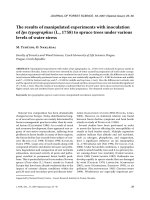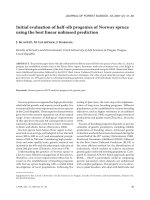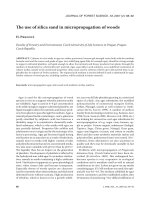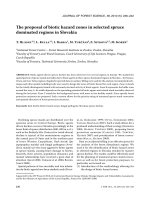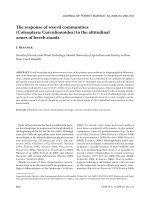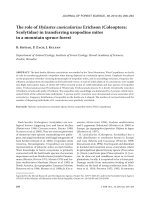Báo cáo lâm nghiệp: "The influence of selected factors on energy requirements for plain milling of beech wood" ppsx
Bạn đang xem bản rút gọn của tài liệu. Xem và tải ngay bản đầy đủ của tài liệu tại đây (1.18 MB, 8 trang )
J. FOR. SCI., 56, 2010 (5): 243–250 243
JOURNAL OF FOREST SCIENCE, 56, 2010 (5): 243–250
In an effort to make use of the highest volume
of wood mass from a tree for the best quality as-
sortments we are looking for ways of utilizing the
logs with some defects such as e.g. false heart. On a
European scale, the false heart most often occurs in
the tree species beech, which is the most important
broadleaved species not only in Slovakia from the
viewpoint of its commercial use. erefore some
European regions created all-embracing working
groups who strive to reach a universal goal, which
is an improvement of market acceptance of beech
heartwood. Orientation is focused on the production
of exclusive furniture (Ř 2009).
At present, with constantly rising claims for wood
processing and a subsequent increase in prices, the
question of energy intensity (G 2008) of produc-
tion has come to the fore. Milling as one of the basic
and widespread methods of wood-working strongly
depends on electrical energy.
Annual costs of energy used in wood processing
reach multi-million amounts. But it is possible to
decrease them by a proper use of individual param-
eters entering into the interactive process machine
– tool – workpiece and simultaneously to create an
optimization model of the given process. is aspect
is a crucial task of each experimental study aimed at
the solution of the above-mentioned problems.
For fulfilment of these often contradictory tasks it
is also necessary to elaborate input data on electrical
energy consumption, i.e. the cutting input.
e present paper tries to furnish the scientific and
professional community who should further proceed
in these problems with the part of this data aimed
at the investigation of the influence of v
c
– cutting
speed (ms
–1
) v
f
– feed speed (mmin
–1
), tool angu-
lar geometry and mainly the beech species with and
without false heart on cutting input.
MATERIAL AND METHODS
The main aim of the verification experimental
investigation was to study, on the basis of measure-
ments of beech species with and without false heart,
the influence of selected factors of energy require-
ments at plain milling of beech wood on cutting
input as well as on basic technological parameters v
c
and v
f
,
and on the tool angular geometry of a milling
machine in the process of plain milling.
Another goal of the experiment was the determi-
nation of bulk density of individual beech assort-
ments and the comparison of results with available
information on the given problems.
Energy requirements were assessed on the basis
of measurement and evaluation of electric input
e influence of selected factors on energy requirements
for plain milling of beech wood
Š. B
1
, R. K
2
, T. Ř
1
, M. K
2
1
Department of Wood Processing, Faculty of Forestry and Wood Sciences,
Czech University of Life Sciences Prague, Prague, Czech Republic
2
Department of Wood Working, Faculty of Wood Sciences and Technology, Technical University
in Zvolen, Zvolen, Slovakia
ABSTRACT: e paper deals with differences in energy requirements for cutting input at plain milling of beech wood
with and without false heart with different changing parameters of cutting and feed speed and angular geometry of the
tool. Created on optimal model from the aspect of not only energy consumption but also the quality of milling, which
would also decisively affect the economic indicators of the wood – working process.
Keywords: angular geometry; beech; cutting input; cutting speed; false heart; feed speed; milling
244 J. FOR. SCI., 56, 2010 (5): 243–250
consumption (W) of the milling machine drive. All
measurements were carried out simultaneously
with the measurements aimed at the investigation
of the influence of the above-mentioned factors on
cutting input.
Machinery and tool
Experiments were realized on a single-spindle
drilling machine of FVS type; feed was provided by
STEFF feeding device (Fig. 1).
Parameters of the machine: electric current
360/220 (V), frequency 50 Hz, electric motor power
requirement (P
em
) = 4 kW, technical speed (n
t
) =
3,000, 4,500, 6,000, 9,000 (rev
.
min
–1
) and respective
cutting speeds with tool diameter 130 mm, v
c
= 20,
30, 40, 60 ms
–1
, manufacturer: Czechoslovak Musi-
cal Instruments in Hradec Králové.
Parameters of the feeding device 2034: P
em
= 0.8 kW,
n
t
= 1,400/2,800 min
–1
, v
f
= 4, 8, 11, 12
m
.
min
–1
.
e used tool was a double-tool milling cutter
with exchangeable knives (Fig. 2) with 1 mm over-
hang against each other.
Parameters of the milling machine: tool diameter
ø = 125 mm, diameter with offset tools = 130 mm,
width = 45 mm, number of knives = 2. ree mill-
ing heads with rake angles (γ) = 15°, 20°, 25° and
knives with the cutting-wedge angle (β) = 45°, with
respective back-angles (α) = 20°, 25°, 30° and cut
-
ting angles (δ) = 65°, 70° and 75° were used for the
experiment.
Material of knives: Maximus special 55: 19 855
with chemical composition C = 0.7, Cu 4.2, W = 18.0,
V = 1.5, CO = 4.7 and hardness after hardening
HRC 64.
Characteristics of raw material
e basic experimental raw material consisted of
beech samples – dimension timber (Fagus sylvati-
ca [L.]) with false heart (heartwood) and without
heart (softwood), length 1 m, width 50 mm and
thickness 35 mm, knot-free and straight grained,
radial. Dimension timber was handled from sawn
timber 3 m long, kiln dried to moisture content 10%
and trimmed to initial thickness 30 mm. eir aver-
age density was determined according to the Stand-
ard ČSN 49 0108 with false heart at 708 kgm
–3
and
without false heart at 725 kgm
–3
, which represents
2.4% difference.
Measuring of cutting input
At experimental measurements of cutting input the
common principle of measurement was used based
on monitoring changes in the current drawn by an
electric motor from the mains by Metrel Power Q
Fig. 1. Milling machine with feeding device
Fig. 2. Milling machine with exchangeable knives
J. FOR. SCI., 56, 2010 (5): 243–250 245
plus MT 2392 measuring equipment (Fig. 3) accord-
ing to the methods, i.e. the analysis of the quality of
mains (R, K 2005; S, F
2009).
e equipment records changes in drawn cur-
rent, actual value of voltage U and on the basis of
the recorded phase shift (3
rd
phase) the equipment
is able to evaluate the input of an electric motor;
the recorded values were in an interval of 1 second
(1,024 valuess
–1
).
e equipment calculated from the measured val-
ues the actual cutting output according to
1
1,024
P
x
= –––––––
∑
U
jx
× I
jx
1,024
φ=1
and total input P
s
= P
1
+ P
2
+ P
3
(W).
where:
P
x
– actual cutting output
U
jx
– voltage factor
I
jx
– stream factor
P
s
– total cutting output
P
1
–P
3
– phases cutting output
The equipment was connected to a computer
through RS232 interface and the data were processed
by means of Power QLink 2.1. software (H
2008). Measured values of cutting input were evalu-
ated by Microsoft Excel program and subsequently
processed statistically by the program STATISTICA
in 8.0 multifactor analyses of variance.
Experimental measurements
e experiments were conducted in operating
conditions of the workshops and laboratories of
Cyech University of Life Sciences Prague, Faculty of
Forestry and Wood Sciences, Department of Wood
Processing. The opposite direction principle of
move in plain milling parallel with grains in tangen-
tial direction was used according to L J
et al. (1996). e measurements were accomplished,
with observed parameters on three levels: v
c
= 20,
30, 40 ms
–1
, v
f
= 4, 8, 11 mmin
–1
and angular ge-
ometry of rake angles γ = 15, 20, 25° separately for
beech with true heart and without false heart and
Fig. 3. Metrel Power Q plus MT 2390 measuring equipment with the wiring scheme
Power plant
measuring instruments
High
voltage
Mean
Mean ± SE
Mean ± SD
Out values
Extreme
Beech without false heart Beech with false heart
Kind of material
1,200
1,100
1,000
900
800
700
600
500
400
300
200
Cutting input P (W)
Fig. 4. Dependence of cutting input on
the kind of material (SE – standard error,
SD – standard deviation)
L1
L2
L3
708
725
246 J. FOR. SCI., 56, 2010 (5): 243–250
Table 1. Concrete values of cutting input at different combinations of measured parameters
Feed speed
v
f
(mmin
–1
)
Rake angle
γ (°)
Cutting input P (W)
Difference
(%)
without false heart with false heart
4
15
705.97 760.48 7.17
8 777.96 806.83 3.58
11 799.48 815.84 2.0
4
20
615.13 649.67 5.32
8 676.05 729.03 7.27
11 727.97 779.03 6.55
4
25
566.08 604.80 6.4
8 619.46 682.18 9.19
11 641.56 652.22 1.63
Feed speed
v
f
(mmin
–1
)
Cutting speed
v
c
(ms
–1
)
4
20
462.96 513.76 9.89
8 528.99 556.55 4.95
11 536.81 568.53 5.58
4
30
535.71 564.39 5.08
8 608.86 637.78 4.53
11 666.67 651.03 –2.40
4
40
888.50 936.81 5.16
8 935.62 1,023.70 8.60
11 965.53 1,027.52 6.03
Cutting speed
v
c
(ms
–1
)
Rake angle
γ (°)
20
15
574.13 597.90 3.98
30 679.07 680.11 0.15
40 1,030.22 1,105.14 6.78
20
20
501.00 551.55 9.17
30 598.29 625.60 4.36
40 919.86 980.58 6.19
20
25
453.64 489.38 7.30
30 533.88 547.50 2.49
40 839.58 902.31 6.95
the size of taken off layer was e = 3 mm (thickness of
remote layer). For each combination of parameters,
the experimental material was investigated with
double motion of the machine, i.e. 2 bm (common
meter) milled length, where the scanned values cre-
ated one date file.
RESULTS AND DISCUSSION
The evaluation of the influence of beech with
false heart and without it on cutting input is pre-
sented in Fig. 4 and Table 1 showing average values
of the combination of observed parameters with
J. FOR. SCI., 56, 2010 (5): 243–250 247
Table 1 to be continued
Cutting speed
v
c
(ms
–1
)
Feed speed
v
f
(mmin
–1
)
Cutting input P (W)
Difference
(%)
without false heart with false heart
20
4
462.96 513.76 9.89
30 535.71 564.39 5.08
40 888.50 936.81 5.16
20
8
528.99 556.55 4.95
30 608.86 637.78 4.53
40 935.62 1,023.70 8.60
20
11
536.81 568.53 5.58
30 666.67 651.03 –2.40
40 965.53 1,027.52 6.03
Rake angle
γ (°)
Feed speed
v
f
(mmin
–1
)
15
4
705.97 760.48 7.17
20 615.13 649.67 5.32
25 566.08 604.80 6.40
15
8
777.96 806.83 3.58
20 676.05 729.03 7.27
25 619.46 682.18 9.19
15
11
799.48 815.84 2.00
20 727.97 779.03 6.55
25 641.56 652.22 1.63
Rake angle
γ (°)
Cutting speed
v
c
(ms
–1
)
15
20
574.13 597.90 3.98
20 501.00 551.55 9.17
25 453.64 489.38 7.30
15
30
615.13 649.67 5.32
20 676.05 729.03 7.27
25 727.97 779.03 6.55
15
40
1,030.22 1,105.14 6.78
20 919.86 980.58 6.19
25 839.58 902.31 6.95
percentage expression of differences between both
materials.
It follows from the results of evaluation that the
average cutting input of beech with false heart is
slightly higher (by an average value 5.7%) than in
beech without false heart. e difference in percent-
age did not exceed 10% in any of these cases in the
given combination of studied parameters; a higher
value of cutting input was always reached in materi-
als with false heart. e main reason for this fact lies
in their different density.
From the practical point of view, the given differ-
ence is not significant; therefore in the next statistical
processing of the influence of observed parameters
on cutting input we used both these materials to-
gether.
248 J. FOR. SCI., 56, 2010 (5): 243–250
e results of the influence of observed parameters
from the common values of both these materials are
presented in Table 2 and in Figs. 5–8. It follows from
the statistical evaluation by multifactor analysis of
variance that the influence of all observed factors
on cutting input is significant, and the order of their
significance was v
c
– cutting speed, γ – rake angle, i.e.
angular geometry of the tool, and
v
f
– feed speed.
e common relation was confirmed that with the
rising feed speed the cutting input also increases.
e reason is that with an increase in v
f
, the feed
of the material which must be taken off within the
same time unit also increases. is requires a higher
cutting input. e higher increase in cutting input
was recorded in transition from the feed speed 4 to
8 mmin
–1
, namely by 9.5%.
In transition from v
f
= 8–11 m
.
min
-1
, an increase
in cutting input only by 2.8% was recorded.
An increase in cutting speed v
c
was manifested
similarly like in v
f
by an increase in cutting input
Table 2. Analysis of variance for the dependence of cutting input on feed speed, cutting speed and angular geometry
SS
Degrees of
freedom
PC F P
Absolute term 26,574,862 1 26,574,862 14,854.59 0.000000
Rake angle γ (°) 210,269 2 105,134 58.77 0.000000
Cutting speed v
c
(m
.
s
–1
) 1,926,095 2 963,048 538.32 0.000000
Feed speed v
f
(m
.
min
–1
) 64,417 2 32,208 18.00 0.000011
Rake angle × cutting speed 11,427 4 2,857 1.60 0.203811
Rake angle × feed speed 6,555 4 1,639 0.92 0.468889
Cutting speed × feed speed 2,482 4 620 0.35 0.843870
Rake angle × cutting speed × feed speed 8,053 8 1,007 0.56 0.798650
Error 48,303 27 1,789
SS – sum of squares, PC – disspersion, F – F-test, P – p-level of signifikance
Fig. 5. Graph of the analysis of variance for the dependence of cutting input on feed speed, cutting speed and angular geo-
metry
γ (°) 15
γ (°) 20
γ (°) 25
v
c
(m
.
s
–1
) 20 30 40 20 30 40 20 30 40
v
f
(m
.
min
–1
) 4 v
f
(m
.
min
–1
) 8 v
f
(m
.
min
–1
) 11
Cutting input P (W)
1,300
1,200
1,100
1,000
900
800
700
600
500
400
300
J. FOR. SCI., 56, 2010 (5): 243–250 249
but in this case it was manifested more significantly,
when the rise from 20–30 ms
–1
was more gradual,
and represented the change from v
c
= 30–40 ms
–1
,
which means as much as 36.6%.
Among the evaluated rake angles the angle
γ = 25° was shown as optimal, with the lowest
cutting input. The cutting input decreases almost
linearly with the decreasing angle; with the change
of the angle γ from 15° to 20°, a decrease in cutting
input by 11.8% was observed and with the change
of the angle γ from 20° to 25° there was a decrease
in input by 111%.
Fig. 6. Dependence of cutting input on
feed speed
4 8 11
Feed speed v
f
(m
.
min
–1
)
780
760
740
720
700
680
660
640
620
Cutting input P (W)
Fig. 7. Dependence of cutting input on
cutting speed
20 30 40
Cutting speed v
c
(m
.
s
–1
)
Cutting input P (W)
1,050
1,000
950
900
850
800
750
700
650
600
550
500
450
Fig. 8. Dependence of cutting input on
rake angle
15 20 25
Rake angle γ (°)
Cutting input P (W)
820
800
780
760
740
720
700
680
660
640
620
600
580
250 J. FOR. SCI., 56, 2010 (5): 243–250
Based on the experiments an equation was deter-
mined arising from the regression of cutting input,
i.e. from the energy requirements of the plain milling
process with the following observed parameters:
P = 262.057 + 15.27γ +21.8v
c
+ 11.82v
f
where:
P –
cutting input (W)
γ – rake angle (°)
v
c
– cutting speed (ms
–1
)
v
f
– feed speed (mmin
–1
)
CONCLUSION
From the presented results of experimental meas-
urements we can draw a conclusion that the ex-
periments have univocally confirmed the fact that a
change in the observed parameters v
c
, γ and v
f
leads
to significant changes in energy requirements for
plain milling (B et al. 2007) of beech wood; the
difference between cutting inputs in milling of beech
wood with and without false heart is negligible.
With the increasing feed speed, the cutting input
also increases, as well as with an increase in cutting
speed, when the rise is the most intensive above
30 ms
–1
; an increase in the value of the rake angle
causes a decrease in cutting input. So, with regard to
the acquired results of cutting input, in plain milling
it is ideal to choose the lowest possible rake angle and
feed speed. On the other hand, it is also necessary to
consider the fact that such a decrease in cutting input
will result in a decrease in production capacity.
In conclusion it is necessary to state that the issue
of plain milling of beech wood is very complex and
in the context of the results of the above-mentioned
experiments it is inevitable to further extend the
knowledge of investigated parameters concerning
individual influences from the aspect of e.g. geom-
etry and quality of machining. is would create an
optimal model from the aspect of not only energy
consumption but also the quality of milling, which
would also decisively affect the economic indicators
of the wood-working process.
Re fere nces
B Š., P E., K R. (2007): e influ-
ence of technological and material factors on energy output
at plane milling of juvenile poplar wood. In: Proceedings
Ambienta 2007, 18
th
International Conference, New Tech-
nologies and Materials in Forest Based Industries. Zagreb,
19. November 2007. Sveučilište u Zagrebu, Šumarski
Fakultet: 107–112.
ČSN 49 0108 Wood density survey. (in Slovak)
G M.: (2008) Embassed surface of the wood moding. [Ph.
D. esis.] Zvolen, Technická univerzita vo Zvolene: 86.
(in Slovak)
H I. (2008): Effect of cutting height on beech prize
cutting power horizontal band saw trisal HTŽ – 1100. In:
Proceedings VI. MVK – Trieskové a beztrieskové obrábanie
dreva 2008. Štúrovo, September 2008. Město vydání a vy-
davatel doplnit: 105–111. (in Slovak)
L J. 1996: eory and technology of wood processing.
Zvolen, Matcentrum: 102. (in Slovak)
R M., K Z. (2005): Monitoring of power
consumption in high speed milling. Drvna industrija, 56:
121–126.
Ř T. (2009): Influence of technical and technological
and material factors in the energy intensity in plane milling.
[M.Sc. esis.] Praha, ČZU: 78. (in Czech)
S M., F D. (2009): e influence of the
selected factors on the cutting input power in sawing
frozen beech wood. In: Proceedings 3
rd
ISC Woodworking
Technique. Zalesina, September 2009. Zagreb, Faculty of
Forestry: 101–108.
Received for publication December 21, 2009
Accepted after corrections March 1, 2010
Corresponding author:
doc. ing.Š B, CSc., Česká zemědělská univerzita v Praze, Fakulta lesnická a dřevařská,
165 21 Praha 6-Suchdol, Česká republika
tel.: + 420 224 383 737, fax: + 420 224 383 732, e-mail: barcik@fld.czu.cz
